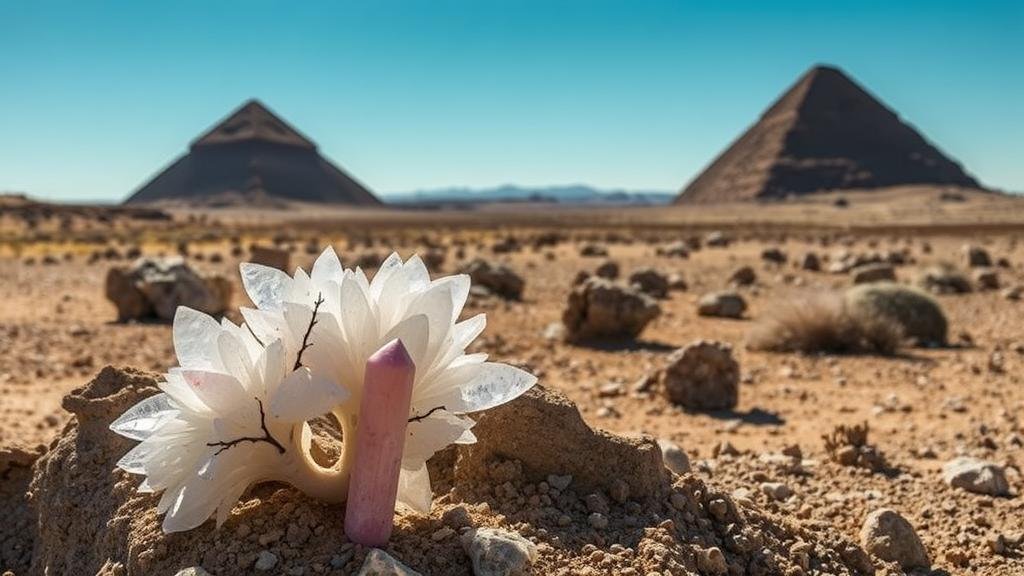Exploring chalcedony roses and barite crystals in the arid terrain around the Pyramid Mountains.
Exploring Chalcedony Roses and Barite Crystals in the Arid Terrain Around the Pyramid Mountains
The Pyramid Mountains, nestled in the southwestern United States, are a geological wonder that beckons rockhounds and mineral collectors alike. Among the unique specimens found in this arid terrain are chalcedony roses and barite crystals. Both minerals offer insights into the regions geological history and provide stunning additions to any collection.
An Introduction to Chalcedony Roses
Chalcedony roses, also known as flower agate or chrysanthemum stone, are a captivating form of chalcedony, a microcrystalline variety of silica. e stones typically feature intricate, flower-like patterns that arise from the mineral’s unique formation process.
In the Pyramid Mountains, chalcedony roses can be found coating ancient basalt flows, a testament to the area’s volcanic history. The roses are formed through a slow crystallization process, where silica-rich solutions seep into volcanic rock and cool, creating the distinct flower patterns.
Identification and Characteristics
Chalcedony roses are characterized by:
- Color: Often appear in shades of cream, beige, white, and light pink.
- Texture: Smooth, with a glassy luster.
- Pattern: The unique “flower†formations can resemble petals or leaves, varying from specimen to specimen.
Collectors should note that the best specimens are typically found in places with exposed volcanic rock, where weathering has removed superficial layers to reveal the beautiful chalcedony underneath.
Barite Crystals: A Geological Marvel
Barite, or barium sulfate (BaSOâ‚„), is another remarkable mineral found in the Pyramid Mountains. Known for its high specific gravity and unique crystal formations, barite often appears in tabular or prismatic shapes.
The geology of the Pyramid Mountains contributes to the formation of barite crystals. Typically, they form in sedimentary deposits, often associated with lead, zinc, and copper ores following geological processes like hydrothermal activities.
Characteristics and Identification of Barite Crystals
Distinguishing barite involves several key features:
- Color: Commonly found in shades of colorless, white, yellow, or blue.
- Hardness: Ranks 3 to 3.5 on the Mohs scale; it can be easily scratched with a knife.
- Crystal Form: Displays distinctive double pyramidal forms that can be striking in appearance.
Barite’s unique property–its high density (4.3 to 4.6 g/cm³)–makes it a favored mineral for various industrial applications, including oil drilling and as a filler in products like paints and plastics.
Collecting Tips for Rockhounds
For rockhounds and mineral collectors planning a venture to the Pyramid Mountains, here are practical tips to enhance your collecting experience:
- Timing: The best time to visit is during the spring and fall when temperatures are milder.
- Tools: Bring basic tools such as a rock hammer, a hand lens, a sieve, and sturdy gloves for safety.
- Location: Focus on areas near dry riverbeds or old volcanic formations where chalcedony and barite are likely to be found.
- Legalities: Ensure to check local regulations regarding mineral collection, as some areas may be protected.
The Unique Ecosystem of the Pyramid Mountains
The arid terrain surrounding the Pyramid Mountains hosts a unique ecosystem that contributes to the formation of these fascinating minerals. The harsh climate limits plant and animal life, but it also reduces soil cover, exposing mineral-rich rock conducive to collecting.
Ecological Considerations
While exploring, it is crucial to remember the importance of conserving the environment. Rockhounds should practice Leave No Trace principles:
- Avoid disturbing wildlife and their habitats.
- Collect sustainably; only take what you can reasonably use and leave the rest for future collectors.
- Fill in any holes or disturbances caused by your activities.
Conclusion
Chalcedony roses and barite crystals found in the Pyramid Mountains are more than just beautiful specimens; they represent complex geological processes that tell the story of the region’s history. For rockhounds and mineral collectors, the allure of discovering these unique minerals is a rewarding experience that combines adventure, education, and a connection to the natural world. Equip yourself with the proper tools and knowledge, respect the environment, and enjoy the captivating landscape of the Pyramid Mountains.


